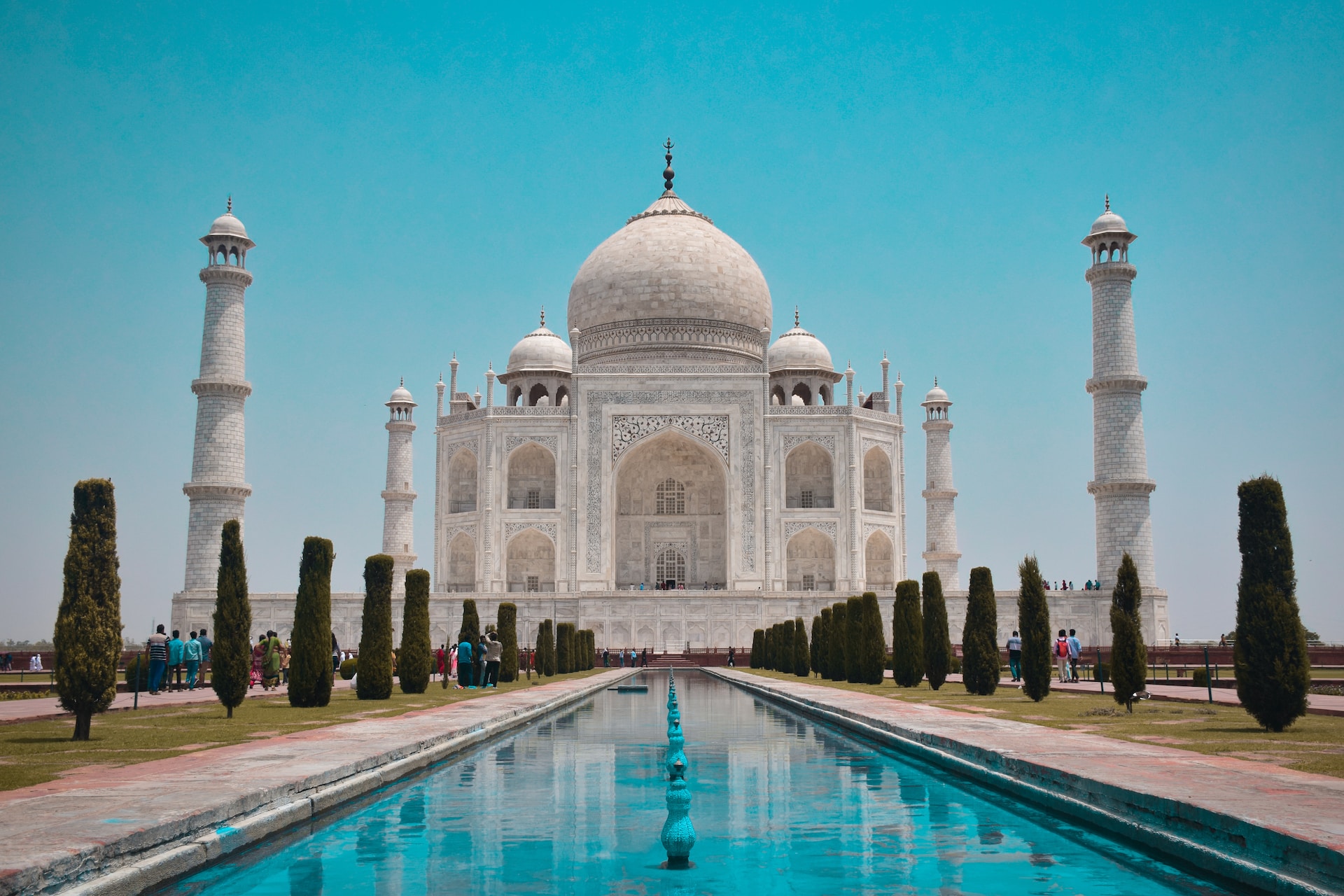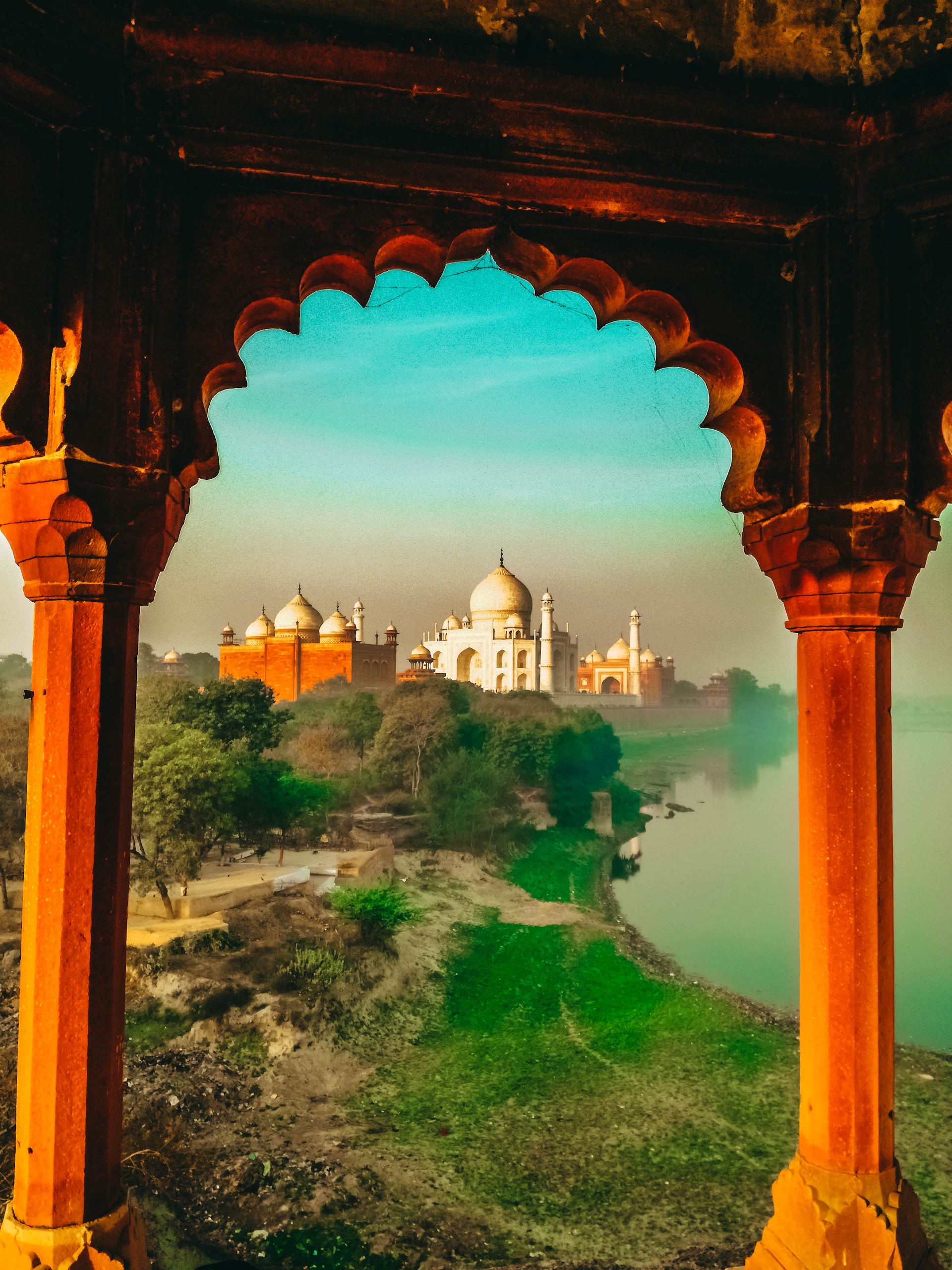
Taj Mahal
The Taj Mahal, often referred to as ‘a teardrop on the cheek of eternity’ by Rabindranath Tagore, ‘the embodiment of all things pure’ by Rudyard Kipling, and causing ‘the sun and the moon shed tears from their eyes’ according to its creator, Emperor Shah Jahan, stands as an iconic monument that captivates the hearts of countless visitors. Every year, more tourists than twice the population of Agra cross its gates to catch a once-in-a-lifetime glimpse of what is widely hailed as the world’s most magnificent architectural masterpiece. Rarely does anyone leave disappointed.
Built by Emperor Shah Jahan as a tribute to his third wife, Mumtaz Mahal, who passed away while giving birth to their 14th child in 1631, the Taj is a symbol of undying love. The grief of Mumtaz’s demise left the emperor so shattered that his hair supposedly turned grey almost overnight. Commencing construction the following year, the main structure took around eight years to complete, with the entire complex finally finished by 1653. Not long after its completion, Shah Jahan was dethroned by his son Aurangzeb and imprisoned within the Agra Fort. For the rest of his life, he could only gaze upon his creation through a window. Upon his death in 1666, Shah Jahan was laid to rest alongside his beloved Mumtaz within the Taj’s confines.
Approximately 20,000 laborers from India and Central Asia contributed to the construction, with specialists even coming from distant Europe to craft the intricate marble screens and pietra dura (marble inlay work) adorned with countless semi-precious stones.
Designated as a World Heritage Site in 1983, the Taj remains nearly as pristine today as it was when first erected, despite a major restoration undertaking in the early 20th century.
Taj Mahal Entry & Information
Please note that the Taj is closed every Friday except for those attending prayers at the mosque.
Access to the Taj is available through both the west and east gates. The south gate was shut to visitors in 2018 due to security concerns, but it can still be used as an exit. Generally, the east gate has shorter queues. Separate queues are designated for men and women at both gates. Foreign visitors enjoy the advantage of bypassing the lines of Indian visitors upon purchasing tickets – a perk of their higher entry fee. Tickets can be bought in advance online, but this doesn’t significantly reduce the time spent in the main security queue. An additional fee is required for entry to the mausoleum itself.
While cameras and videos are allowed, photography is prohibited inside the mausoleum, and tripods are not permitted.
Don’t forget to collect your complimentary 500ml water bottle and shoe covers (included in the Taj ticket price). Holding onto your ticket can also secure minor entry-fee discounts when visiting Agra Fort, Fatehpur Sikri, Akbar’s Tomb, or the Itimad-ud-Daulah on the same day. Larger bags exceeding the size of a money pouch are not allowed inside, but free bag storage is provided. Any food or tobacco products will be confiscated during the security check, as will pens.
Inside the Taj Mahal Premises
Upon entering through the east or west gates, you find yourself in a grand inner courtyard featuring an imposing 30-meter red sandstone gateway on its southern side.
The meticulously designed gardens adhere to the classical Mughal charbagh (formal Persian garden) layout – a square divided by watercourses, with an ornate marble platform at its center. When the fountains are inactive, the Taj’s reflection in the water is a captivating sight.
Sitting atop a raised marble platform at the north end of the ornamental gardens, the Taj Mahal itself stands with its back against the Yamuna River. Its elevated positioning ensures the sky as its sole backdrop, showcasing a brilliant design choice. Decorative white minarets, standing 40 meters high, grace each corner of the platform. While not perfectly perpendicular after more than three centuries, they may have been intentionally inclined slightly outward to safeguard the Taj in case of an earthquake. The red sandstone mosque to the west serves as an important congregation site for Agra’s Muslim population. Its counterpart to the east, known as the jawab, was constructed for the sake of symmetry.
The central structure of the Taj is crafted from translucent white marble, intricately carved with floral patterns and adorned with intricate inlay work comprising thousands of semi-precious stones. A symmetrical marvel, each of the Taj’s four identical facades features impressive vaulted arches embellished with pietra dura scrollwork and excerpts from the Quran rendered in an inlaid jasper calligraphy style. Topping off the structure are four small domes encircling the renowned bulbous central dome.
Just beneath the main dome lies the Cenotaph of Mumtaz Mahal, an elaborate symbolic tomb enclosed by a delicate marble screen adorned with various types of semi-precious stones. Adjacent to it, disrupting the Taj’s symmetry, stands the Cenotaph of Shah Jahan, who was laid to rest here with minimal ceremony by his son Aurangzeb in 1666. Illumination graces the central chamber through meticulously carved marble screens.
The actual tombs of Mumtaz Mahal and Shah Jahan rest in a subterranean chamber beneath the main chamber.
-
Top Taj Views
Prime Taj Mahal views abound: Mehtab Bagh across the Yamuna offers serene panoramas; from Agra Fort, witness history’s embrace; and within the Taj complex, the iconic reflecting pool frames the maestro. Don’t miss sunrise or sunset’s magical hues!
